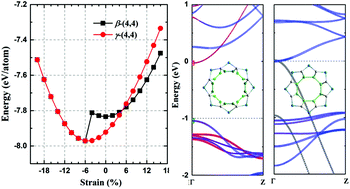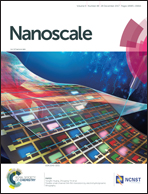Novel penta-graphene nanotubes: strain-induced structural and semiconductor–metal transitions†
Abstract
Research into novel one-dimensional (1D) materials and associated structural transitions is of significant scientific interest. It is widely accepted that a 1D system with a short-range interaction cannot have 1D phase transition at finite temperature. Herein, we propose a series of new stable carbon nanotubes by rolling up penta-graphene sheets, which exhibit fascinating well-defined 1D phase transitions triggered by axial strain. Our first-principles calculations show that such penta-graphene nanotubes (PGNTs) are dynamically stable by phonon calculations, but transform from a tri-layer structure to a highly defective single-walled nanotube at low temperature in molecular dynamics simulations. We show that moderate compressive strains can drive structural transitions of (4,4), (5,5), and (6,6) PGNTs, during which the distances of neighboring carbon dimers in the inner shell have a sudden drop, corresponding to dimer–dimer nonbonding to bonding transitions. After such transition, the tubes become much more thermally stable and undergo semiconductor–metal transitions under increasing strain. The band gaps of PGNTs are not sensitive to chirality whereas they can be tuned effectively from visible to short-wavelength infrared by appropriate strain, making them appealing materials for flexible nano-optoelectronics. These findings provide useful insight into unusual phase transitions in low-dimensional systems.



 Please wait while we load your content...
Please wait while we load your content...